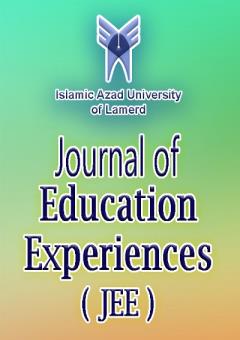An Examination of the Growth of Scientific Inquiry in the Area of Financial Literacy
محورهای موضوعی : 0
mohsen molapanah
1
![]() ,
Yousef Namvar
2
,
azam rastgoo
3
,
majid ahmadloo
4
,
turan Soleimani
5
,
Yousef Namvar
2
,
azam rastgoo
3
,
majid ahmadloo
4
,
turan Soleimani
5
1 - Islamic Azad University, Ardabil branch
2 - Ardabil Branch, Islamic Azad University, Ardabil, IRAN
3 - Department of Educational Sciences, Ardabil Branch, Islamic Azad University, Ardabil, Iran
4 - Management, Humanities, Islamic Azad University of Ardabil
5 - Department of Educational Sciences, Ardabil Branch, Islamic Azad University, Ardabil, Iran
کلید واژه: financial literacy, financial behavior, financial instruments, scientometrics, meta-analysis,
چکیده مقاله :
This article examines the background and impact of financial literacy and the growth of scientific papers in the "Financial Literacy" field in the citation database "Web of Science". The methodology used is a meta-analysis of the "Scientometrics" type. The entire body of scientific literature published in the Web of Science reference database between 1900 and 2020 served as the study's statistical population. 2036 scientific papers on financial literacy published in this citation database formed the research sample in the first stage. In the second stage, 888 scientific documents with the keyword financial literacy in their titles were examined from the 2036 scientific documents to examine their conceptualizations. The results of this study show that financial literacy has received much attention in the last decade and that the geographical and linguistic distribution of scientific production in financial literacy is significantly heterogeneous and oriented towards developed Western countries. Therefore, it is suggested to pay more attention to this issue in developing countries.
This article examines the background and impact of financial literacy and the growth of scientific papers in the "Financial Literacy" field in the citation database "Web of Science". The methodology used is a meta-analysis of the "Scientometrics" type. The entire body of scientific literature published in the Web of Science reference database between 1900 and 2020 served as the study's statistical population. 2036 scientific papers on financial literacy published in this citation database formed the research sample in the first stage. In the second stage, 888 scientific documents with the keyword financial literacy in their titles were examined from the 2036 scientific documents to examine their conceptualizations. The results of this study show that financial literacy has received much attention in the last decade and that the geographical and linguistic distribution of scientific production in financial literacy is significantly heterogeneous and oriented towards developed Western countries. Therefore, it is suggested to pay more attention to this issue in developing countries.
References
Ansari, Y., Albarrak, M. S., Sherfudeen, N., & Aman, A. (2023). Examining the relationship between financial literacy and demographic factors and the overconfidence of Saudi investors. Finance Research Letters, 52, 103582.
Bayrakdaroğlu, A., & Şan, F. B. (2014). Financial literacy training as a strategic management tool among small–medium sized businesses operating in Turkey. Procedia-Social and Behavioral Sciences, 150, 148-155.
Brüggen, E. C., Hogreve, J., Holmlund, M., Kabadayi, S., & Löfgren, M. (2017). Financial well-being: A conceptualization and research agenda. Journal of Business Research, 79, 228-237.
Bureau, C. F. P. (2017). Financial well-being in America.
Das, A. K. (2015). Introduction to research evaluation metrics and related indicators. In Open access for researchers, module 4: research evaluation metrics (pp. 1-18): UNESCO, Paris.
Farahmand, E., Md Nor, M., Ghanbari Baghestan, A., Ale Ebrahim, N., & Matinnia, N. (2018). Five Decades of Scientific Development on'Attachment Theory': Trends and Future Landscape. Pertanika Journal of Social Sciences & Humanities, 26(3), 1-16.
Grenfell, M., Bloome, D., Hardy, C., Pahl, K., Rowsell, J., & Street, B. V. (2013). Language, ethnography, and education: Bridging new literacy studies and Bourdieu: Routledge.
Hung, A., Parker, A. M., & Yoong, J. (2009). Defining and measuring financial literacy.
Krische, S. D. (2019). Investment experience, financial literacy, and investment‐related judgments. Contemporary Accounting Research, 36(3), 1634-1668.
Lusardi, A., & Mitchell, O. S. (2011). Financial literacy and retirement planning in the United States. Journal of Pension Economics & Finance, 10(4), 509-525. doi:https://doi.org/10.1017/S147474721100045X
Lusardi, A., & Oggero, N. (2017). Millennials and financial literacy: A global perspective. Global Financial Literacy Excellence Center, 5, 17. doi:https://gflec.org/wp-content/uploads/2017/07/Millennials-and-Financial-Literacy-Research-Paper.pdf
Milojević, S., & Leydesdorff, L. (2013). Information metrics (iMetrics): A research specialty with a socio-cognitive identity? Scientometrics, 95, 141-157.
Montagnoli, A., Moro, M., Panos, G. A., & Wright, R. (2017). Financial literacy and attitudes to redistribution.
Musavi chalak, A., alaee arani, M., salami, M., & Soheili, F. (2018). Meta-Analaysis Approach to Study the Prevalence of Information Databases Use in Scientometric Reseaches. Iranian Journal of Information Processing and Management, 34(1), 89-112. doi:10.35050/jipm010.2018.004
Mustafa, W. M. W., Islam, M. A., Asyraf, M., Hassan, M. S., Royhan, P., & Rahman, S. (2023). The effects of financial attitudes, financial literacy and health literacy on sustainable financial retirement planning: The moderating role of the financial advisor. Sustainability, 15(3), 2677.
Paiella, M. (2016). Financial literacy and subjective expectations questions: A validation exercise. Research in Economics, 70(2), 360-374.
Pătru-Stupariu, I., & Nita, A. (2022). Impacts of the European Landscape Convention on interdisciplinary and transdisciplinary research. Landscape Ecology, 37(5), 1211-1225.
Remund, D. L. (2010). Financial literacy explicated: The case for a clearer definition in an increasingly complex economy. Journal of Consumer Affairs, 44(2), 276-295. doi:10.1111/j.1745-6606.2010.01169.x
Sharma, M. S. (2013). To study the level of financial literacy and its impact on investment decision–An In-depth analysis of investors in Gujarat state. Ganpat University,
Silgoner, M., Greimel-Fuhrmann, B., & Weber, R. (2015). Financial literacy gaps of the Austrian population. Monetary Policy & the Economy Q, 2, 35-51.
Sivaramakrishnan, S., Srivastava, M., & Rastogi, A. (2017). Attitudinal factors, financial literacy, and stock market participation. International Journal of Bank Marketing.
Van Campenhout, G. (2015). Revaluing the role of parents as financial socialization agents in youth financial literacy programs. Journal of Consumer Affairs, 49(1), 186-222.


